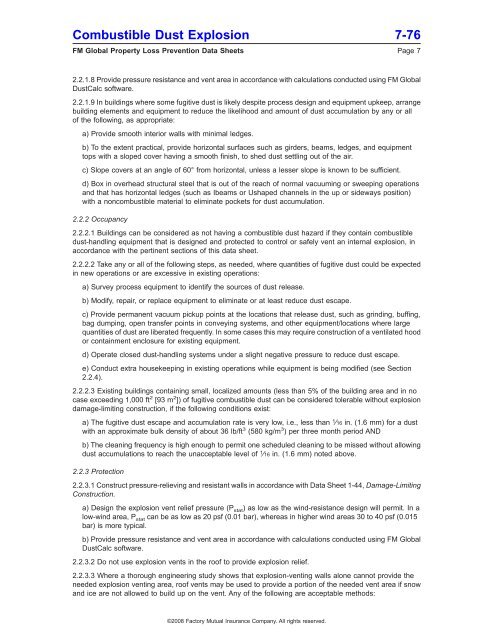DS 7-76 Prevention and Mitigation of Combustible Dust ... - FM Global
DS 7-76 Prevention and Mitigation of Combustible Dust ... - FM Global
DS 7-76 Prevention and Mitigation of Combustible Dust ... - FM Global
Create successful ePaper yourself
Turn your PDF publications into a flip-book with our unique Google optimized e-Paper software.
<strong>Combustible</strong> <strong>Dust</strong> Explosion 7-<strong>76</strong><br />
<strong>FM</strong> <strong>Global</strong> Property Loss <strong>Prevention</strong> Data Sheets Page 7<br />
2.2.1.8 Provide pressure resistance <strong>and</strong> vent area in accordance with calculations conducted using <strong>FM</strong> <strong>Global</strong><br />
<strong>Dust</strong>Calc s<strong>of</strong>tware.<br />
2.2.1.9 In buildings where some fugitive dust is likely despite process design <strong>and</strong> equipment upkeep, arrange<br />
building elements <strong>and</strong> equipment to reduce the likelihood <strong>and</strong> amount <strong>of</strong> dust accumulation by any or all<br />
<strong>of</strong> the following, as appropriate:<br />
a) Provide smooth interior walls with minimal ledges.<br />
b) To the extent practical, provide horizontal surfaces such as girders, beams, ledges, <strong>and</strong> equipment<br />
tops with a sloped cover having a smooth finish, to shed dust settling out <strong>of</strong> the air.<br />
c) Slope covers at an angle <strong>of</strong> 60° from horizontal, unless a lesser slope is known to be sufficient.<br />
d) Box in overhead structural steel that is out <strong>of</strong> the reach <strong>of</strong> normal vacuuming or sweeping operations<br />
<strong>and</strong> that has horizontal ledges (such as Ibeams or Ushaped channels in the up or sideways position)<br />
with a noncombustible material to eliminate pockets for dust accumulation.<br />
2.2.2 Occupancy<br />
2.2.2.1 Buildings can be considered as not having a combustible dust hazard if they contain combustible<br />
dust-h<strong>and</strong>ling equipment that is designed <strong>and</strong> protected to control or safely vent an internal explosion, in<br />
accordance with the pertinent sections <strong>of</strong> this data sheet.<br />
2.2.2.2 Take any or all <strong>of</strong> the following steps, as needed, where quantities <strong>of</strong> fugitive dust could be expected<br />
in new operations or are excessive in existing operations:<br />
a) Survey process equipment to identify the sources <strong>of</strong> dust release.<br />
b) Modify, repair, or replace equipment to eliminate or at least reduce dust escape.<br />
c) Provide permanent vacuum pickup points at the locations that release dust, such as grinding, buffing,<br />
bag dumping, open transfer points in conveying systems, <strong>and</strong> other equipment/locations where large<br />
quantities <strong>of</strong> dust are liberated frequently. In some cases this may require construction <strong>of</strong> a ventilated hood<br />
or containment enclosure for existing equipment.<br />
d) Operate closed dust-h<strong>and</strong>ling systems under a slight negative pressure to reduce dust escape.<br />
e) Conduct extra housekeeping in existing operations while equipment is being modified (see Section<br />
2.2.4).<br />
2.2.2.3 Existing buildings containing small, localized amounts (less than 5% <strong>of</strong> the building area <strong>and</strong> in no<br />
case exceeding 1,000 ft 2 [93 m 2 ]) <strong>of</strong> fugitive combustible dust can be considered tolerable without explosion<br />
damage-limiting construction, if the following conditions exist:<br />
a) The fugitive dust escape <strong>and</strong> accumulation rate is very low, i.e., less than 1 ⁄16 in. (1.6 mm) for a dust<br />
with an approximate bulk density <strong>of</strong> about 36 lb/ft 3 (580 kg/m 3 ) per three month period AND<br />
b) The cleaning frequency is high enough to permit one scheduled cleaning to be missed without allowing<br />
dust accumulations to reach the unacceptable level <strong>of</strong> 1 ⁄16 in. (1.6 mm) noted above.<br />
2.2.3 Protection<br />
2.2.3.1 Construct pressure-relieving <strong>and</strong> resistant walls in accordance with Data Sheet 1-44, Damage-Limiting<br />
Construction.<br />
a) Design the explosion vent relief pressure (P stat) as low as the wind-resistance design will permit. In a<br />
low-wind area, P stat can be as low as 20 psf (0.01 bar), whereas in higher wind areas 30 to 40 psf (0.015<br />
bar) is more typical.<br />
b) Provide pressure resistance <strong>and</strong> vent area in accordance with calculations conducted using <strong>FM</strong> <strong>Global</strong><br />
<strong>Dust</strong>Calc s<strong>of</strong>tware.<br />
2.2.3.2 Do not use explosion vents in the ro<strong>of</strong> to provide explosion relief.<br />
2.2.3.3 Where a thorough engineering study shows that explosion-venting walls alone cannot provide the<br />
needed explosion venting area, ro<strong>of</strong> vents may be used to provide a portion <strong>of</strong> the needed vent area if snow<br />
<strong>and</strong> ice are not allowed to build up on the vent. Any <strong>of</strong> the following are acceptable methods:<br />
©2008 Factory Mutual Insurance Company. All rights reserved.

















